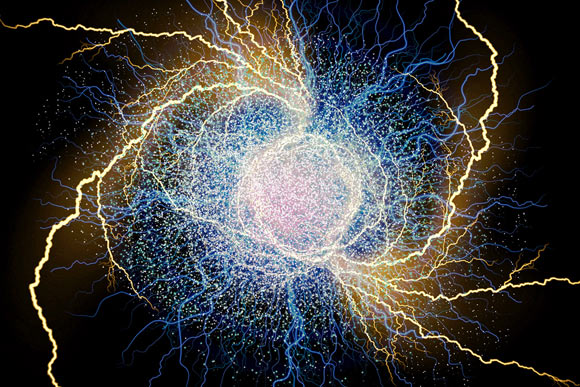An international team of physicists has observed electrons flowing in vortices — a hallmark of fluid flow that theorists predicted electrons should exhibit, but that has never been seen until now.

Electron vortices could be leveraged for next-gen low-power electronics. Image credit: Christine Daniloff, MIT.
When electricity runs through most ordinary metals and semiconductors, the momenta and trajectories of electrons in the current are influenced by impurities in the material and vibrations among the material’s atoms. These processes dominate electron behavior in ordinary materials.
But theoretical physicists have predicted that in the absence of such ordinary, classical processes, quantum effects should take over.
Namely, electrons should pick up on each other’s delicate quantum behavior and move collectively, as a viscous, honey-like electron fluid.
This liquid-like behavior should emerge in ultraclean materials and at near-zero temperatures.
In 2017, MIT Professor Leonid Levitov and his colleagues from the University of Manchester reported signatures of such fluid-like electron behavior in graphene.
They observed that a current sent through the channel could flow through the constrictions with little resistance. This suggested that the electrons in the current were able to squeeze through the pinch points collectively, much like a fluid, rather than clogging, like individual grains of sand.
In a new study, Professor Levitov and physicists from the Weizmann Institute for Science looked to visualize electron vortices.
They focused on tungsten ditelluride (WTe2), an ultraclean metallic compound that has been found to exhibit exotic electronic properties when isolated in single-atom-thin, 2D form.
“Tungsten ditelluride is one of the new quantum materials where electrons are strongly interacting and behave as quantum waves rather than particles,” Professor Levitov said.
“In addition, the material is very clean, which makes the fluid-like behavior directly accessible.”
The researchers synthesized pure single crystals of tungsten ditelluride, and exfoliated thin flakes of the material.
They then used e-beam lithography and plasma etching techniques to pattern each flake into a center channel connected to a circular chamber on either side.
They etched the same pattern into thin flakes of gold — a standard metal with ordinary, classical electronic properties.
They then ran a current through each patterned sample at ultralow temperatures of 4.5 K and measured the current flow at specific points throughout each sample, using a nanoscale scanning superconducting quantum interference device (SQUID) on a tip.
Using the device to scan each sample, they were able to observe in detail how electrons flowed through the patterned channels in each material.
The authors observed that electrons flowing through patterned channels in gold flakes did so without reversing direction, even when some of the current passed through each side chamber before joining back up with the main current.
In contrast, electrons flowing through tungsten ditelluride flowed through the channel and swirled into each side chamber, much as water would do when emptying into a bowl.
The electrons created small whirlpools in each chamber before flowing back out into the main channel.
“We observed a change in the flow direction in the chambers, where the flow direction reversed the direction as compared to that in the central strip,” Professor Levitov said.
“That is a very striking thing, and it is the same physics as that in ordinary fluids, but happening with electrons on the nanoscale. That’s a clear signature of electrons being in a fluid-like regime.”
The results appear today in the journal Nature.
_____
A. Aharon-Steinberg et al. Direct observation of vortices in an electron fluid. Nature, published online July 6, 2022; doi: 10.1038/s41586-022-04794-y







